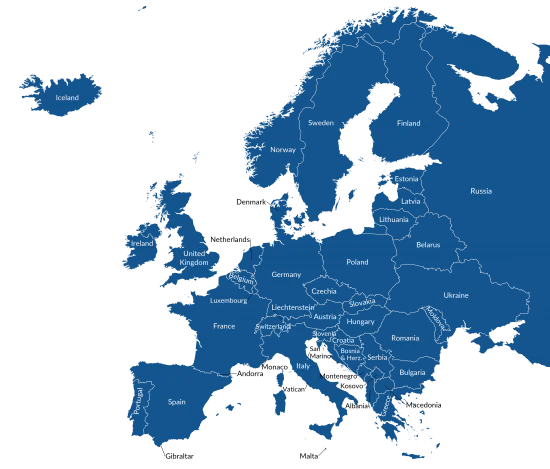About Europe
The European continent is located entirely in the Northern Hemisphere and mostly in the Eastern Hemisphere. There is a total of 44 countries that come under Europe.
Facts about the Europe continent |
|
|---|---|
| Size | Europe has an area of 10.18 million square kilometers, making it the second smallest continent. |
| Population | Europe is the third most populous continent, after Asia and Africa, with a population of approximately 747 million people. |
| Countries | Europe is home to 44 countries, including Russia, Germany, France, Spain, and the United Kingdom. |
| Languages | Over 200 languages are spoken in Europe, with the most widely spoken being Russian, German, French, and English. |
| Religion | Christianity is the dominant religion in Europe, with Catholicism and Protestantism being the major denominations. Europe’s second-largest religion is Islam. |
| Economy | It has a GDP of over $18 trillion. |
| Landmarks | Europe is home to many famous landmarks, including the Eiffel Tower in Paris, the Colosseum in Rome, and the Big Ben clock tower in London. |
Geography of Europe
Location and Size
The European continent occupies an area of 10.18 million square kilometers, and it is the third most populous after Asia and Africa. It is located to the east of North America, across the Atlantic Ocean, and to the west of Asia, across the Ural Mountains and the Caspian Sea.
Topography
The Alps are the highest mountain range in Europe, located in the central and southern parts of the European continent.
Climate
Europe has a temperate climate, with mild summers and cold winters. The climate varies depending on the region, with the northern part of the continent being colder than the southern part. The Mediterranean region has a warm and dry climate, while the northern parts of Europe have a colder and wetter climate.
History of Europe
Ancient History
Europe has a rich ancient history, with civilizations like the Greeks and Romans leaving a significant cultural and historical legacy. The ancient Greeks developed democracy and made important contributions to philosophy, mathematics, and literature. The Roman Empire, which spanned over 500 years, shaped the political and cultural landscape of Europe and beyond.
Medieval History
The Middle Ages saw the rise of powerful empires and kingdoms in Europe, such as the Holy Roman Empire, the Byzantine Empire, and the Norman Kingdom of Sicily. The period was also marked by the Crusades, a series of religious wars fought between Christian and Muslim forces.
Modern History
The modern history of Europe is characterized by the rise of nation-states, the Industrial Revolution, and two world wars. The Treaty of Westphalia in 1648 marked the end of the Thirty Years’ War and the beginning of the modern European state system. The Industrial Revolution, which began in the 18th century, led to significant economic growth and social change. The two world wars in the 20th century had a profound impact on Europe, leading to the formation of the European Union and the establishment of democracy in many countries.
Countries in Europe
| Country | Capital |
|---|---|
| Albania | Tirana |
| Andorra | Andorra la Vella |
| Austria | Vienna |
| Belarus | Minsk |
| Belgium | Brussels |
| Bosnia and Herzegovina | Sarajevo |
| Bulgaria | Sofia |
| Croatia | Zagreb |
| Cyprus | Nicosia |
| Czech Republic | Prague |
| Denmark | Copenhagen |
| Estonia | Tallinn |
| Finland | Helsinki |
| France | Paris |
| Germany | Berlin |
| Greece | Athens |
| Hungary | Budapest |
| Iceland | Reykjavik |
| Ireland | Dublin |
| Italy | Rome |
| Kosovo | Pristina |
| Latvia | Riga |
| Liechtenstein | Vaduz |
| Lithuania | Vilnius |
| Luxembourg | Luxembourg City |
| Malta | Valletta |
| Moldova | Chisinau |
| Monaco | Monaco |
| Montenegro | Podgorica |
| Netherlands | Amsterdam |
| North Macedonia | Skopje |
| Norway | Oslo |
| Poland | Warsaw |
| Portugal | Lisbon |
| Romania | Bucharest |
| Russia | Moscow |
| San Marino | San Marino |
| Serbia | Belgrade |
| Slovakia | Bratislava |
| Slovenia | Ljubljana |
| Spain | Madrid |
| Sweden | Stockholm |
| Switzerland | Bern |
| Ukraine | Kiev |
| United Kingdom | London |
Top 10 Must-See Places to Visit in Europe
| Place | Country |
|---|---|
| Paris | France |
| Rome | Italy |
| Barcelona | Spain |
| Amsterdam | Netherlands |
| Berlin | Germany |
| Vienna | Austria |
| Santorini | Greece |
| Prague | Czech Republic |
| Budapest | Hungary |
| Edinburgh | United Kingdom |
FAQs
Q: How many countries are in Europe?
A: 44 countries.
Q: What is the official currency in Europe?
A: Euro

